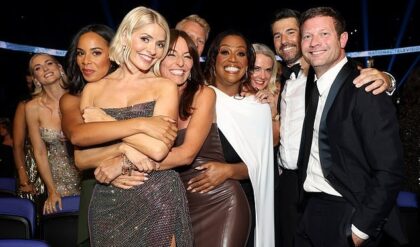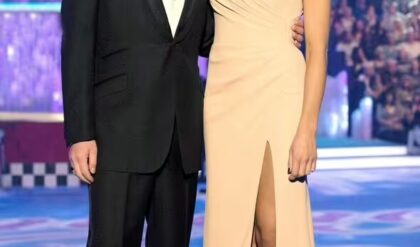When Jodie Foster accepted the Golden Globes’ Cecil B. DeMille Award for “outstanding contributions to the world of entertainment” in January 2013, she was, at 50, the award’s fourth-youngest honoree. It was in keeping with a lifetime of Foster always seeming ahead of most everyone else. She started acting at age 3, appearing first in commercials, then on television, where her credits included everything from Mayberry R.F.D. to The Courtship Of Eddie’s Father to The Amazing Chan And The Chan Clan (she provided the voice of Anne Chan) to a short-lived series based on Paper Moon, where she stepped into a role originated by Tatum O’Neal.
That night, however, it wasn’t Foster’s career that left people talking, but her speech, which stepped up to the line of making a public declaration of her sexuality—an open secret she’d never directly acknowledged—then stepped back. Or did it? There aren’t many ways to interpret, “I already did my coming out about a thousand years ago back in the Stone Age” and acknowledging the “ex-partner in love” with whom she was raising her children. Then the speech kept going. Foster spoke of her pride in her children, her love for the mother (now stricken with dementia) who steered her into show business, her appreciation of her professional support system, and her much-puzzled-about friendship with Mel Gibson, all before suggesting she might retire or otherwise step away from her current career.
It was a rambling, frustrating, elusive, and ultimately moving monologue that felt made up on the spot. And as committed as Foster remains to keeping her life private and her career public, at that moment, one felt like a mirror of the other. Foster’s film work has been filled with triumphs, disappointments, wrong turns, comebacks, and ambitious sidesteps, but in every phase it’s remained, in the word stressed by Robert Downey Jr. in his Globes introduction, exceptional. It’s also, when looked at from start to finish, a seemingly improvised journey that follows no course but the one Foster has made for herself.
Child, actor (1974-1979): Lost girls and little women
★★★★★
Alice Doesn’t Live Here Anymore (1974)
★★★★★
Taxi Driver (1976)
★★★★★
Bugsy Malone (1976)
★★★★★
The Little Girl Who Lives Down The Lane (1976)
★★★★★
Freaky Friday (1976)
★★★★★
Candleshoe (1977)
Foster appeared in a number of films as a young child, from unremarkable parts as “the kid” in films like Kansas City Bomber to high-profile Disney productions like Napoleon And Samantha, where she was nearly mauled by a lion. But it only took a handful of scenes in Martin Scorsese’s Alice Doesn’t Live Here Anymore to announce her arrival as an acting force, no matter her age. Playing Audrey, a poorly supervised young girl from Tucson, she asks an inexperienced new-kid-in-town “Wanna get high on Ripple?” with the matter-of-fact delivery of someone asking the time of day. That moment echoed through her performances in the next few years, which found her playing girls with experience beyond their age, or at least the skills to fake that experience.

Foster reunited with Scorsese for Taxi Driver, which let her explore the most extreme contrast between a character’s innocent appearance and the worldly airs in which she cloaks herself. Playing Iris, a 12-year-old runaway who’s turned to prostitution under the thrall of an abusive pimp (Harvey Keitel), she asserts her independence to Robert De Niro’s Travis Bickle when he expresses a desire to rescue her from the life into which she’s fallen. By Iris’ reckoning, she hasn’t fallen at all, but the notes of doubt make the performance. No matter what Iris says, she still looks the part of a kid, and her delivery makes it clear that on some level, she knows she’s just playing at adulthood.
In one way or another, Foster’s films from this period offer variations on the tension between childhood and adulthood. A dopey but deft comedy in which Foster plays a teen who switches bodies with her mother (Barbara Harris), Freaky Friday takes that tension to a comic extreme. The bizarre Alan Parker musical Bugsy Malone casts her as a femme fatale in a gangster film with an all-kid cast where the central joke comes from letting the kids play the grown-up scenes perfectly straight. In the agreeable Candleshoe—like Freaky Friday, another Disney family film—Foster plays a homeless orphan who takes pride in her ability to fend for herself on the streets of Los Angeles (or at least their backlot approximation). Then she discovers how much she’s missed having a family when she poses as the rightful heir to a country estate owned by Helen Hayes.
Foster is good in both films, but the real gem from this era is the low-budget, Canadian-shot The Little Girl Who Lives Down The Lane. Directed by Nicolas Gessner and adapted from a novel by Laird Koenig, the film stars Foster as Rynn, a young teen who lives with her father in a large Victorian house she rents from a local matriarch named Mrs. Hallet (Alexis Smith). Or at least Rynn claims her father lives with her. When first Mrs. Hallet, then Frank—Hallet’s ne’er-do-well son, played by Martin Sheen, who talks to Rynn lasciviously and follows her around town—start to wonder why they’ve never seen Rynn’s dad, Rynn takes extreme measures to ensure her privacy and independence. Spookily underpopulated and shot with the chill of autumn in the air, the film is simultaneously creepy and tender, especially when Rynn strikes up a sweet romance with a misfit boy who does magic tricks at local birthday parties. She lets down her guard and allows herself be a kid, but only a little, and never for long. Like the other characters Foster played in this stretch, Rynn is hard on the outside, no matter what she feels inside.
The in-between years (1980-1987): Growing up in public
★★★★★
Foxes (1980)
★★★★★
Carny (1980)
★★★★★
The Hotel New Hampshire (1984)
★★★★★
Mesmerized (a.k.a. My Letter To George) (1986)
★★★★★
Five Corners (1987)
★★★★★
Siesta (1987)
Concurrent to her Hollywood career, Foster also spent time working in Europe in the late 1970s, where she appeared in now hard-to-track-down movies like the Italian comedy Casotto and the French Moi, Fluer Bleue, the latter of which also led to a short stint in the world of French pop music. 1980 reintroduced her in Hollywood as a young actor ready to put childhood roles behind her and begin the most difficult phase of her career. In Adrian Lyne’s Foxes, she plays the most levelheaded of a group of L.A. teens who spend their days skipping school and their nights chasing pills with booze. Just as she serves as the sensible center of her clique, her performance grounds a film that otherwise doesn’t know whether it wants to sound an alarm about youth gone wild, or eroticize it.

As Foster got older, she still seemed stuck playing roles about growing up too fast. In the little-seen Carny, she plays a waitress who lands in the middle of an odd love triangle with a clown (Gary Busey) and a carnival’s sharp-dealing manager (Robbie Robertson) as she learns the often-unforgiving ways of carny life. Taunting customers in a raspy voice, Busey has most of the memorable scenes, but the heart of the story belongs to Foster’s character, who learns to navigate a world in which there are only those who get taken advantage of, and those who do the taking. She had started taking parts that got her to the other side of growing up, though the process wasn’t always easy.
Foster also began attending Yale in 1980, and in the spring of her freshman year, she was swept into history when obsessive fan John Hinckley, Jr. attempted to assassinate Ronald Reagan. The subsequent press attention reinforced her taste for privacy and coincided with a period in which films like The Hotel New Hampshire, a tone-deaf adaptation of John Irving’s book, drew little attention. After college, Foster struggled professionally. Playing yet another girl thrust too soon into adulthood, she’s unmemorable in the historical drama Mesmerized as Victoria, a New Zealand child bride to John Lithgow; she’s gamely over-the-top, however, as a debauched English socialite in Mary Lambert’s nutty, awful, weirdly compelling 1987 film Siesta. The same year, Foster appeared in Five Corners, an ensemble piece written by John Patrick Shanley and co-starring Tim Robbins and John Turturro, which saw Foster slipping easily into the costumes and cadences of early-1960s New York. Overlooked at the time, but well worth rediscovering, it suggested that Foster had a bright future in supporting roles. A different future beckoned.

Major motion pictures (1988-1998): Comebacks, awards, and other adventures
★★★★★
Stealing Home (1988)
★★★★★
The Accused (1988)
★★★★★
Backtrack (a.k.a. Catchfire) (1990)
★★★★★
The Silence Of The Lambs (1991)
★★★★★
Little Man Tate (also dir.) (1991)
★★★★★
Sommersby (1993)
★★★★★
Maverick (1994)
★★★★★
Nell (1994)
★★★★★
Home For The Holidays (dir. only) (1995)
★★★★★
Contact (1997)
Foster won the first of her two Best Actress Oscars for her work in 1988’s The Accused, a role she pursued in an effort to give acting one last shot, intending to leave the profession for grad school if it didn’t work out. It’s also a part she struggled to land. Speaking to James Lipton during an appearance on Inside The Actors Studio, Foster describes having to “bang on all the doors” to get an audition, then struggling to convince studio executives to believe in her acting choices and give her the role. It was worth the effort; Foster’s grad-school plans remain on hold.
The Accused arrived on the heels of a career low, Stealing Home, in which Foster plays, in flashback, the childhood sweetheart of a future professional baseball player who’s charged in adulthood with disposing of her ashes after she commits suicide. In this sentimental wreck of a film, Foster leans hard on acting tricks she’d employed since childhood, particularly a husky reserve that grew more distancing than intriguing over the years. Watching her in the fact-inspired The Accused means seeing her throw those tricks out the window. Playing Sarah, the victim of a gang rape, Foster holds nothing back as she struggles to earn a just verdict for her attackers—and the bystanders who egged them on—and with it, reclaim a portion of the dignity taken from her. Though director Jonathan Kaplan creates a little of the darkness-at-the-edge-of-town atmosphere he summoned up in Over The Edge, The Accused seldom reaches beyond the limits of the legal drama. But it seldom has to, thanks to Foster’s performance, which alchemizes fear and humiliation into rage, and later, uses heartbreaking frankness in pursuit of justice.
The performance isn’t a total reinvention, however: Sarah shares with Foster’s past and future characters a passion for integrity and a desire to keep a portion of herself for herself. She got a chance to explore that, for a bit at least, in her ill-fated next film, Backtrack (a.k.a. Catchfire). Directed by Dennis Hopper—though the cut released in the U.S. bore the nom de shame “Alan Smithee”—it eventually turns into a dull kidnapping drama with erotic aspirations, as Foster’s character falls in love with Hopper after he sexually forces himself on her. (That’s a curious choice, directly after The Accused.) But in the film’s opening stretches, Foster is quietly superb as an artist forced to go underground after witnessing a mob hit, and using it as an opportunity to walk away from the life she’s created without ever looking back.

If nothing else, Backtrack served as a warm-up for The Silence Of The Lambs, in which Foster plays Clarice Starling, another type of self-invented woman. Forced to form an alliance with psychiatrist and serial killer Hannibal Lecter (Anthony Hopkins), she shares stories from her life in exchange for guidance with an ongoing case, reluctantly giving away pieces of her past as a means to an end. Directed by Jonathan Demme, the film is a stunning example of what happens when everything that can go right with a movie does go right, even when things seem to go wrong. Foster was Demme’s second choice for the part, after Michelle Pfeiffer, but now it’s hard to imagine anyone else in the role. (Even Julianne Moore’s turn as Starling in the sequel, Hannibal, has largely faded from memory.) Foster turns her face into a mask of competency and assurance, then lets Clarice’s involuntary blinks and unplanned pauses reveal just how scared she is beneath the surface.
Foster won her second Oscar for the part, which helped establish her ability to make her own way through Hollywood. That included a second career as a director starting with Little Man Tate, the story of a child prodigy with whom Foster has said she felt a special affinity, thanks to her own background. Foster also co-stars, playing a mother reluctant to hand off her gifted child (Adam Hann-Byrd) to a teacher specializing in young geniuses (Dianne Wiest). It’s a promising debut, but one that too often opts for big, dramatic acting moments over compelling storytelling. Four years later, Foster’s second directorial effort, the episodic, Holly Hunter-starring Home For The Holidays, often fell into the same trap. The film veers wildly between aggressively comic performances (particularly Robert Downey Jr. as Hunter’s prankish gay brother) and quiet, dramatic stretches, ultimately feeling like a collection of interesting pieces and vivid performances that never cohere into a whole.
The years around those directorial efforts saw Foster developing the frustrating habit of being the best element of films that don’t fully work, no matter how lofty their aims. Even when working in the mainstream, Foster rarely makes safe choices. Though Richard Donner’s Maverick is a remake of a TV show, it felt out of place in summer 1994. Casting Foster as a fast-talking con artist, it begins as a promisingly witty throwback, but loses momentum as it goes along. Sommersby, a remake of The Return Of Martin Guerre, gave her the challenge of staying sympathetic even as her character’s motivations—or understanding of what’s going on around her—remain unclear. While it’s an earnest, ambitious film, it also falls apart by the end. As a woman raised apart from society, speaking a nearly incomprehensibly warped version of English, Nell provided Foster with a part that others would have treated as a chance to showboat. Instead, she emphasized the humanity beneath her character’s almost feral behavior, a complex accomplishment at odds with the ultimately simpleminded film.

In the period between Silence Of The Lambs and Panic Room in 2002, only Robert Zemeckis’ adaptation of Carl Sagan’s novel Contact surrounded Foster with a film that lived up to her abilities. The film casts Foster as Dr. Ellie Arroway, an astronomer who’s devoted her career to the possibility of contacting extraterrestrial life. Foster again plays a woman apart, isolated by intellect and a belief in a universe that’s richer than the one most people around her imagine. Zemeckis’ film cuts hard science with sentiment and sentiment with hard science, balancing both on the back of Foster’s performance. She gives Ellie a forceful intellect, but also a soul-deep drive to explore and explain. Like so many Foster characters, Ellie has been battered by the world, and has chosen to forge armor rather than retreat.
Lifer (1999-present): Predators and prey
★★★★★
Anna And The King (1999)
★★★★★
The Dangerous Lives Of Alter Boys (2002)
★★★★★
Panic Room (2002)
★★★★★
A Very Long Engagement (2004)
★★★★★
Flightplan (2005)
★★★★★
Inside Man (2006)
★★★★★
The Brave One (2007)
★★★★★
Nim’s Island (2008)
★★★★★
The Beaver (also dir.) (2011)
★★★★★
Carnage (2011)
★★★★★
Elysium (2013)
Foster ended the 1990s on an unmemorable note with Anna And The King, a handsome but dull retelling of the real-life story that inspired The King And I. Outside of a small role in the coming-of-age drama The Dangerous Lives Of Altar Boys (which she also produced), she didn’t resurface until 2002, when she took over for an injured Nicole Kidman in David Fincher’s Panic Room. It was a film surrounded by mishaps, setbacks, and unforeseen circumstances: Foster learned she was pregnant a few weeks into shooting, and her participation was only made possible by the collapse of Flora Plum, which would have been her third movie as a director, had star Russell Crowe not been forced to drop out due to an injury. Bad fortune conspired to make Panic Room into a superior, claustrophobic thriller, however, with Foster rising to the challenge of a physically demanding role made all the more difficult by Fincher’s famously exacting process. But no matter how intense the action, Foster’s performance remains focused on the emotions of a mother trying, fiercely and with increasing desperation, to protect her child.

Flightplan, her next major role apart from an important French-language cameo in Jean-Pierre Jeunet’s A Very Long Engagement, offered a virtual reprise of that part in the service of an effective, but not particularly challenging, suspense film. Spike Lee’s much better Inside Man cast Foster as a discreet New York problem-solver who becomes involved in a bank robbery masterminded by Clive Owen. In retrospect, the role looks like a turning point in Foster’s career, one that allowed her to start introducing darker notes after a long string of essentially heroic parts. She took this development further the following year with The Brave One, a vigilante film directed by Neil Jordan. Foster plays Erica Bain, a public-radio host who picks up a gun and starts searching for revenge after the murder of her fiancée. She’s effective as a woman who’s been cracked inside, a condition years of on-air poise allow her to hide from the rest of the world. (In addition to armor, she now carries arms.) It’s a powerful, understated (relative to the film) performance that lets her riff on Taxi Driver while surrounded by the lush, urban darkness of the sort Jordan summons up so well. Too bad the under-considered material, particularly the cop-out ending, lets her down.
With Nim’s Island, Foster returned to family films, playing Alex Rover, an agoraphobic children’s-book author, and again providing the most compelling element in a less-than-compelling film. Though it’s a fundamentally comic turn, Foster invests Alex’s mental illness with considerable gravity, playing her as a woman crippled by forces she can’t control. She picked up the subject again with The Beaver, her third directorial effort. A tricky, maybe impossible mix of family drama, black comedy, and modern fable, the film stars Mel Gibson as a depressed business tycoon who takes to communicating through a chipper, sometimes threatening beaver puppet. It’s Foster’s most ambitious directorial effort to date, a serious attempt to engage with the realities of depression, and it’s filled with strong performances—Gibson’s among them. It earns more points for what it tries than what it accomplishes, but it deserves a wider audience than the one it found during a halfhearted release overshadowed by the scandals following Gibson.
Foster finished out the year with an appearance in Carnage, Roman Polanski’s adaptation of Yasmine Reza’s play God Of Carnage. Like many theatrical adaptations, it has trouble shaking its stage-bound origins, but it does let Foster play one of the least sympathetic characters in her career. The performance paved the way for her work as an outright villain in Elysium, a rare misstep in which Foster appears unengaged and uninterested in developing the part beyond her character’s odd, untraceable accent. But paired with Carnage and her other recent work, it also suggests a future freed from the burden of likability. Foster began by playing girls who act as if they’ve seen it all, and aged into playing women who’ve seen too much. As for what she does next, Foster’s future will remain exceptional, and exceptionally hard to predict.



